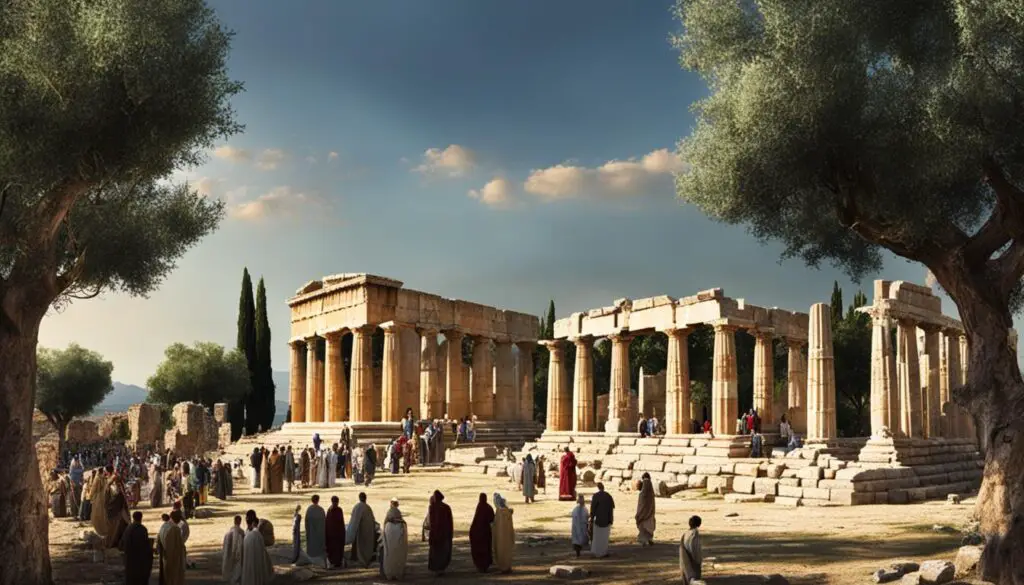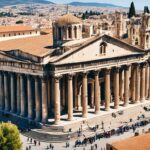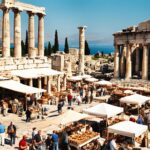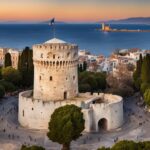Welcome to Corinth, an ancient city in Greece that holds a significant place in history. Situated in the Peloponnese region, Corinth is a captivating tourist attraction and a treasure trove of archaeological wonders. From the Corinth Canal to the ancient ruins that dot the landscape, this city offers a fascinating glimpse into the past.
In biblical times, Corinth played a crucial role and holds great biblical importance. It was visited by the Apostle Paul and was mentioned in his letters to the Corinthians in the New Testament. Notable biblical figures, such as Jason, Priscilla, and Aquila, were associated with Corinth, and major biblical events unfolded in the city, leaving a lasting impact on its history.
The city’s appearance and function in biblical times were remarkable. It was strategically positioned on the isthmus connecting mainland Greece with the Peloponnese. Corinth had a bustling commercial center, a vibrant trade industry, and a thriving naval fleet. The city was adorned with temples, theaters, the agora, and other architectural marvels that showcased its wealth and culture.
Today, Corinth continues to attract visitors with its impressive archaeological site. Ancient ruins, including the Temple of Apollo and the Corinthian Grand Theater, offer a glimpse into the region’s ancient civilization and architectural achievements. The Acrocorinth, a rock fortress, stands as a testament to Corinth’s strategic importance in the past.
Whether you’re interested in delving into the biblical significance of Corinth, exploring its ancient ruins, or admiring the engineering marvel of the Corinth Canal, this city has something for everyone. Immerse yourself in Corinth’s history, appreciate its natural beauty, and uncover the layers of its captivating past.
Key Takeaways:
- Corinth is an ancient city in Greece, known for its historical significance and archaeological wonders.
- Biblical figures like the Apostle Paul, Jason, Priscilla, and Aquila were associated with Corinth.
- In biblical times, Corinth was a thriving commercial center with impressive architectural structures.
- Major biblical events, including the Apostle Paul’s presence and teachings, shaped Corinth’s religious landscape.
- Today, Corinth offers visitors a chance to explore its ancient ruins, including the Temple of Apollo and the Corinthian Grand Theater.
The Biblical Significance of Corinth
Corinth holds great biblical importance. It was visited by the Apostle Paul in the 1st century CE and is mentioned in his letters to the Corinthians in the New Testament. The city was also inhabited by various notable biblical figures, such as Jason, who settled there with Medea after obtaining the Golden Fleece, and Priscilla and Aquila, who worked closely with Paul. Additionally, important biblical events occurred in Corinth, such as Paul’s public hearing defending his teachings against accusations from the city’s Hebrews. These biblical connections add to the historical significance of Corinth.
Biblical Figures in Corinth
– Jason: settled in Corinth with Medea after obtaining the Golden Fleece.
– Priscilla and Aquila: worked closely with the Apostle Paul.
Major Biblical Events in Corinth
– Paul’s public hearing defending his teachings against accusations from the city’s Hebrews.
Biblical References to Corinth in the New Testament
“I give thanks to my God always for you because of the grace of God that was given you in Christ Jesus.”
– 1 Corinthians 1:4
“Now concerning the collection for the saints: as I directed the churches of Galatia, so you also are to do.”
– 1 Corinthians 16:1
Ancient Corinth in Biblical Times
In biblical times, Corinth was a thriving city strategically located on the isthmus connecting mainland Greece with the Peloponnese. The city’s appearance showcased its grandeur and wealth, with magnificent structures that reflected its importance as a prominent trading hub. Corinth had an acropolis perched atop a hill, which housed significant buildings like the Temple of Apollo, a symbol of religious devotion and cultural significance.
The city functioned as a bustling commercial center, known for its trade and naval fleet. The Corinthians were renowned for their business acumen, and their economic prosperity contributed to the city’s overall influence in the region. With its abundance of temples, theaters, the agora, baths, and other architectural marvels, ancient Corinth was a testament to the advanced civilization and cultural richness of biblical times.
The biblical importance of Corinth is evident through its association with notable biblical figures and significant events. The city was visited by the Apostle Paul, who played a pivotal role in bringing Christianity to Corinth. Biblical figures like Jason, Priscilla, and Aquila resided in Corinth, shaping the city’s spiritual landscape. Corinth witnessed major biblical events, including Paul’s public hearing defending his teachings against accusations from the Hebrews, which had a profound impact on the city’s history and religious development.
| Key Points: |
|---|
| Strategically positioned on the isthmus connecting mainland Greece with the Peloponnese. |
| A bustling commercial center known for trade and naval fleet. |
| Rich in temples, theaters, and significant architectural structures. |
| Visited by the Apostle Paul and inhabited by notable biblical figures. |
| Witnessed major biblical events that shaped its history. |
Major Biblical Events and Their Impact on Corinth’s History
Corinth, a city of great historical significance, experienced major biblical events that left a lasting impact on its history. These events transformed the religious and cultural landscape of Corinth, shaping its identity as a center of early Christianity in Greece.
The Visit of Apostle Paul
One of the most significant biblical events in Corinth was the visit of the Apostle Paul in the 1st century CE. Paul’s arrival brought Christianity to the city, introducing a new faith that would have a profound influence on its future. His teachings and interactions with the Corinthians laid the foundation for the growth of Christian communities in the region.
Paul’s public hearing and the judgment in his favor played a crucial role in allowing Christian teachings to flourish in Corinth and beyond.
Establishment of Christianity
The presence of early Christians in Corinth had a profound impact on the city’s history. As Paul’s teachings took root, Corinth became a center of early Christianity, with the local community playing an active role in spreading the Christian faith. The establishment of churches, such as the Corinthian Church mentioned in the New Testament, further solidified Corinth’s position as an important Christian stronghold.
Legacy and Historical Development
The major biblical events in Corinth not only influenced its religious landscape but also shaped its historical development. The rise of Christianity in Corinth impacted various aspects of the city, including its culture, social dynamics, and interactions with neighboring regions. Through the centuries, Corinth continued to be recognized as a significant center of Christianity, leaving a lasting legacy that is still evident today.

| Biblical Event | Impact on Corinth |
|---|---|
| Apostle Paul’s Visit | Introduction of Christianity to Corinth |
| Paul’s Public Hearing | Judgment in favor of Christian teachings |
| Establishment of Christian Communities | Corinth becomes a center of early Christianity |
| Corinthian Church | Further solidification of Corinth’s Christian identity |
| Historical Legacy | Continued recognition of Corinth as a significant Christian center |
The major biblical events and their impact on Corinth’s history illustrate the city’s pivotal role in the development of early Christianity. Today, Corinth stands as a testament to the enduring influence of these events, attracting visitors from around the world to explore its rich religious and historical heritage.
The Corinth Canal: A Marvel of Engineering
The Corinth Canal is a remarkable engineering marvel that showcases human ingenuity and serves as a significant point of reference for Greece. Completed in the late 19th century, this canal connects the Gulf of Corinth with the Saronic Gulf, offering a shortcut for maritime traffic. Spanning approximately 6 kilometers, the narrow strip of waterway is an awe-inspiring sight to behold.
The Corinth Canal attracts thousands of visitors who are captivated by its great construction and historical significance. It offers a unique experience for travelers, allowing them to witness firsthand the remarkable feats of engineering achieved by human hands. The canal also provides opportunities for thrilling activities such as bungee jumping, canoeing, and surfing.
Table: Key Facts About the Corinth Canal
| Length | Approximately 6 kilometers |
|---|---|
| Construction period | Late 19th century |
| Connects | Gulf of Corinth and Saronic Gulf |
| Importance | Shortcut for maritime traffic |
The Corinth Canal is not just a testament to human engineering prowess; it also holds historical and cultural significance. It is a testament to the cooperative efforts of ancient civilizations to connect trade routes and facilitate travel. Visitors to Corinth cannot miss the opportunity to witness this engineering marvel and appreciate the lasting impact it has had on the region.
Ancient Corinth: Unveiling the Riches of an Archaeological Gem
Step into the ancient world as you explore the mesmerizing archaeological site of Ancient Corinth. This treasure trove of ancient ruins provides a glimpse into the vibrant history and culture of this legendary city. From the iconic Temple of Apollo to the majestic Corinthian Grand Theater, each structure tells a tale of the city’s past.
The centerpiece of Ancient Corinth is the Archaic Temple of Apollo, dating back to the 7th to 6th century BC. This well-preserved temple stands as a testament to the architectural prowess of the ancient Greeks. As you walk through its impressive columns, you’ll feel the weight of history surrounding you.
“Ancient Corinth is a place where you can truly immerse yourself in the wonders of the past. The archaeological site offers a unique opportunity to witness the grandeur of ancient Greek civilization.”
Another must-see attraction within the site is the Corinthian Grand Theater. With its capacity to hold 18,000 spectators, this theater once hosted performances that captivated ancient audiences. Imagine the echoes of applause and the thunderous applause as you stand within these ancient walls.
| Structures | Historical Significance |
|---|---|
| Temple of Apollo | An iconic place of worship and a testament to ancient Greek architecture. |
| Corinthian Grand Theater | A venue for ancient Greek performances and a symbol of cultural expression. |
| Agora | The bustling heart of ancient Corinth, where commerce and social activities thrived. |
| Roman Forum | A center for public affairs and a testament to the city’s Roman influence. |
As you explore the archaeological site of Ancient Corinth, let the echoes of the past guide your journey. Immerse yourself in the ancient ruins, and witness the grandeur of a civilization that shaped the course of history.

The Acropolis of Corinth
The Acrocorinth is a significant monument located near Corinth. It is a rock 579 meters above sea level and served as the Acropolis of Corinth. The Acrocorinth played a crucial role in the city’s defense, and its fortifications were primarily built during the Middle Byzantine era in the 12th century. Today, it is one of the largest castles in the Peloponnese, with walls that stretch for 3 km. Visitors can explore the Acrocorinth and immerse themselves in the history and strategic importance of this ancient fortress.

The Acrocorinth offers breathtaking views of the surrounding landscape and the city of Corinth. It exemplifies the architectural prowess of the Middle Byzantine era and stands as a testament to the city’s historical significance. The castle’s imposing walls and strategic location allowed for effective defense against invasions, making it a formidable stronghold.
Visitors can explore the various sections of the Acrocorinth, including the gates, towers, and underground cisterns. As they walk along the well-preserved paths and staircases, they can envision the lives of the people who once inhabited this fortress. The Acrocorinth is a must-visit for history enthusiasts and those seeking a deeper understanding of Corinth’s past.
Within the Acrocorinth, there are also archaeological remains that showcase the fortress’s rich history. These include Byzantine churches, Turkish baths, and a mosque, giving visitors a glimpse into the diverse influences that shaped the Acrocorinth over the centuries. The Acrocorinth is not only a significant historical site but also a place of scenic beauty, offering panoramic views of the Corinthian Gulf and the surrounding countryside.
Corinth’s Fascinating Museums
Corinth is not only a city rich in ancient ruins and historical significance, but it is also home to several fascinating museums that offer a deeper insight into its past. These museums showcase the cultural heritage and archaeological discoveries of Corinth, making them must-visit attractions for history enthusiasts.
Archaeological Museum of Ancient Corinth
The Archaeological Museum of Ancient Corinth is a treasure trove of artifacts excavated from the archaeological site. It houses a vast collection that spans various periods, including prehistoric times, the Classical era, Roman times, and the Byzantine period. Visitors can marvel at ancient pottery, sculptures, mosaics, and detailed exhibits that bring ancient Corinth to life. This museum offers a comprehensive understanding of the region’s rich history and the daily lives of its inhabitants.
Environment Museum of Stymphalia
The Environment Museum of Stymphalia provides a unique perspective on the relationship between humans and nature in the Stymphalia basin. This museum focuses on environmental awareness and showcases the traditional technology used in the region throughout history. Visitors can explore exhibits that highlight the natural beauty of Stymphalia and the importance of preserving its ecosystems. With interactive displays and informative presentations, this museum offers an engaging experience for visitors of all ages.
Historical and Folklore Museum of Corinth
The Historical and Folklore Museum of Corinth is dedicated to preserving and showcasing the folklore and historical material of the region. This museum allows visitors to delve into the local traditions, customs, and cultural heritage of Corinth. The exhibits include traditional costumes, agricultural tools, household items, and historical documents, providing insights into the daily lives of the people who lived in Corinth throughout history. It offers a glimpse into the rich cultural tapestry of the region and the traditions that have shaped its identity.
These museums in Corinth offer a unique opportunity to explore the city’s history, culture, and archaeological wonders. From ancient artifacts to environmental awareness and local traditions, each museum provides a different perspective on the fascinating heritage of Corinth. Whether you are a history buff or simply curious about the region’s past, a visit to these museums is sure to deepen your appreciation for the rich and diverse history of Corinth.
The Natural Beauty of the Corinth Area
The Corinth Area is renowned for its breathtaking natural beauty, with stunning lakes that captivate visitors with their picturesque surroundings. Explore the enchanting landscapes of Lake Vouliagmeni, Lake Doxa, and Lake Stymphalia, and discover the tranquility and charm they offer.
Located in close proximity to Corinth, Lake Vouliagmeni is a true gem. With its crystal-clear waters and lush vegetation, it provides a serene escape for nature enthusiasts. The lake, connected to the Corinthian Gulf, offers a peaceful setting where visitors can relax and enjoy the beauty of the surrounding environment.
Another must-visit lake in the Corinth Area is Lake Doxa, an artificial lake situated in the Ancient Feneos of Corinthia. The centerpiece of this tranquil lake is the picturesque chapel of Agios Fanourios. Surrounded by verdant hills and forests, Lake Doxa is the perfect place to immerse yourself in nature and take in the breathtaking scenery.
Lastly, Lake Stymphalia, famous in Greek mythology for its association with Hercules’ sixth labor, is a place of natural wonder. Nestled amid the mountainous landscape of Korinthia, this serene lake is a haven for birdwatchers and nature lovers. It offers a unique opportunity to observe a variety of bird species and appreciate the unspoiled beauty of the Corinth Area.

| Lake | Description |
|---|---|
| Lake Vouliagmeni | A serene lake with crystal-clear waters connected to the Corinthian Gulf. Surrounded by lush vegetation, it offers a tranquil escape for nature lovers. |
| Lake Doxa | An artificial lake located in the Ancient Feneos of Corinthia. The idyllic setting is enhanced by the picturesque chapel of Agios Fanourios. |
| Lake Stymphalia | Located in the mountainous landscape of Korinthia, this lake is famous in Greek mythology. It is a paradise for birdwatchers and nature enthusiasts. |
The Modern City of Corinth
While Corinth is renowned for its ancient history and archaeological wonders, the modern city of Corinth offers a vibrant and engaging experience for visitors. Blending its rich past with contemporary attractions, the city showcases its historical significance through its iconic historic buildings and landmarks.
One notable site in the modern city is the Corinth National Cemetery. Established in the aftermath of the American Civil War, it serves as a solemn reminder of the sacrifices made by the soldiers who fought in the conflict. Walking through the cemetery, visitors can pay their respects and reflect on the nation’s history.
Besides the Corinth National Cemetery, the modern city is also home to various historic buildings that reflect its architectural heritage. From well-preserved structures dating back to before and after the Civil War, visitors can explore and marvel at the intricate craftsmanship and design of these buildings. The blend of old and new creates a unique atmosphere that showcases the city’s evolution over time.
As visitors embark on their exploration of the modern city, they can also visit the Corinth Civil War Interpretive Center and the Crossroads Museum. These cultural institutions provide insights into the region’s history and offer interactive exhibits that engage visitors in an immersive learning experience. Through these attractions, visitors can gain a deeper understanding of the city’s past and its impact on American history.

The modern city of Corinth embraces its rich history while offering modern amenities and attractions for visitors to enjoy. Whether strolling through the Corinth National Cemetery, admiring the historic buildings, or immersing oneself in the cultural institutions, the modern city provides a captivating experience that complements the ancient wonders of Corinth.
Conclusion
Corinth is a captivating city with a rich and diverse history. From its ancient ruins and archaeological site to its modern attractions, the city offers a unique experience for visitors.
One cannot ignore the biblical importance of Corinth. It was visited by the Apostle Paul in the 1st century CE and is mentioned in his letters to the Corinthians in the New Testament. The city was also inhabited by notable biblical figures such as Jason, Priscilla, and Aquila, who played significant roles in biblical events. These connections add to the historical significance of Corinth.
In biblical times, Corinth was a bustling city strategically positioned on the isthmus connecting mainland Greece with the Peloponnese. It had a thriving commercial center, was known for its trade, and boasted impressive architectural structures like temples, theaters, and the agora. The city’s function as a prominent trading hub and its architectural grandeur made it a significant city in biblical times.
Corinth experienced major biblical events that left a lasting impact on its history. The visit of the Apostle Paul and the spread of Christianity shaped the city’s religious landscape, eventually establishing Corinth as a center of early Christianity in Greece. These events, along with the city’s archaeological and natural wonders, have made Corinth a must-visit destination for anyone seeking to uncover the layers of history that have shaped its identity.
FAQ
What is the significance of Corinth in biblical history?
Corinth holds great biblical importance. It was visited by the Apostle Paul in the 1st century CE and is mentioned in his letters to the Corinthians in the New Testament. The city was also inhabited by various notable biblical figures, such as Jason and Priscilla and Aquila. Important biblical events, such as Paul’s public hearing, occurred in Corinth.
What can I expect to see at the archaeological site of Ancient Corinth?
The archaeological site of Ancient Corinth includes various ancient ruins, such as temples, theaters, and the agora. One of the most well-known monuments is the Archaic Temple of Apollo. The Corinthian Grand Theater, with a capacity of 18,000, is also a highlight. The site offers important insights into the region’s ancient civilization and architecture.
How long is the Corinth Canal?
The Corinth Canal is approximately 6 kilometers long. It connects the Gulf of Corinth with the Saronic Gulf, creating a shortcut for maritime traffic. The canal is a notable engineering marvel and attracts thousands of visitors who admire its construction and participate in extreme sports like bungee jumping, canoeing, and surfing.
What is the Acrocorinth?
The Acrocorinth is a significant monument located near Corinth. It is a rock 579 meters above sea level and served as the Acropolis of Corinth. The Acrocorinth played a crucial role in the city’s defense, and its fortifications were primarily built during the Middle Byzantine era. Today, it is one of the largest castles in the Peloponnese.
What are some of the museums in Corinth?
Corinth is home to several fascinating museums. The Archaeological Museum of Ancient Corinth houses numerous objects excavated from the site, including artifacts from prehistoric times. The Environment Museum of Stymphalia highlights the region’s relationship between humans and nature. The Historical and Folklore Museum of Corinth preserves and displays folklore and historical material.
What natural attractions are there in the Corinth Area?
The Corinth Area boasts remarkable natural beauty. It is home to stunning lakes like Lake Vouliagmeni, Lake Doxa, and Lake Stymphalia. These lakes are surrounded by lush vegetation and offer picturesque views. Lake Vouliagmeni connects with the Corinthian Gulf, Lake Doxa features the chapel of Agios Fanourios at its center, and Lake Stymphalia has mythological associations with Hercules.
What can I explore in the modern city of Corinth?
The modern city of Corinth blends its rich history with contemporary attractions. Visitors can explore historic buildings dating back to before and after the Civil War, such as the Corinth National Cemetery. The city offers activities like visits to the Corinth Civil War Interpretive Center and the Crossroads Museum.







